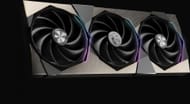A graphics card is the most crucial component of a gaming PC and the driving force behind generating the frames for playing any modern title. Hence, investing in a powerful pixel pusher is necessary to maintain high framerates. Games released in the last couple of years have gotten highly intense; hence, you will have to side with one of the latest releases in the market for good framerates.
There are three major players in the GPU market: Nvidia, AMD, and Intel. Team Blue recently entered their race and is yet to come up with its next-gen Battlemage lineup. The performance crowns for the best GPUs have already been claimed by Nvidia and AMD.
In this article, we will review the best graphics cards you can opt for in early 2024. We focus on competitive performance and good value propositions.
Multiple graphics cards deliver top-notch performance in today's market
5) AMD Radeon RX 7700 XT ($499)

The AMD Radeon RX 7700 XT was primarily launched to take on the RTX 4070 and 4070 Ti GPUs. Although it is fairly competitive at 1440p resolutions, it loses by quite a margin to its Nvidia counterparts. To match up with this, AMD has priced it competitively at $499. At this range, this is the most performance you can get, earning the card a position on this list.
The card is based on the same Navi 32 GPU as the higher-end RX 7800 XT. Moreover, you get 16 GB of VRAM with it, which helps future-proof the card for 1440p and 4K gaming.
Pros:
- The RX 7700 XT delivers competitive 1440p performance at $499.
- You get 16 GB of VRAM with it.
Cons:
- The card doesn't have the best ray-tracing performance.
- AMD's FSR 3 tech is much worse than DLSS 3.
4) AMD Radeon RX 7800 XT ($549)

The AMD Radeon RX 7800 XT is another fantastic mid-premium segment graphics card from Team Red. Although the name suggests it competes with the RTX 4080, it targets the lower-end RTX 4070 and 4070 Ti GPUs. Although the 7800 XT beats the 4070, it is slower than the 4070 Ti. However, with a competitive price tag of $549, the GPU becomes a worthy option.
The graphics card uses the same Navi 32 graphics processor as the 7700 XT. However, you get 3,840 shader units with it, up from the 3,456 on the lower-end offering. The 16 GB VRAM buffer remains constant, but the 7800 XT's memory is faster, resulting in a higher overall bandwidth.
Pros:
- The RX 7800 XT is quite capable at 1440p and 4K resolutions.
- The graphics card is a value-for-money option at just $549.
Cons:
- The ray tracing and upscaling performance of the card is worse than Nvidia equivalents.
3) Nvidia RTX 4070 Ti ($799)

The RTX 4070 Ti was initially supposed to be launched as the 4080 12 GB. However, following massive backlash, Nvidia renamed the card and slashed $100 off its price. Today, it is a formidable pixel pusher at $799. Although the price can be a bit too high, the graphics card can beat the 3090 and 3090 Ti, earning it a spot on this list.
With the AD104 graphics processor and 7,680 CUDA cores, it is a formidable GPU for playing the latest and most demanding video cards in the market. Although Nvidia advertises it as a 1440p card, you can easily get superb 4K performance. However, the VRAM buffer, although plenty for 2024, can become a problem a few years later.
Pros:
- The RTX 4070 Ti is a ridiculously fast video card for 1440p and 4K gaming.
- The card bundles support DLSS 3 with frame generation.
Cons:
- At $799, the GPU can be quite expensive for some.
- The 12 GB VRAM buffer can become a limiting factor down the line.
2) AMD Radeon RX 7900 XT ($899)

The AMD Radeon RX 7900 XT is a flagship-grade graphics card in the RDNA 3 lineup. It utilizes the new architecture to deliver superb 4K gaming performances. Moreover, it is priced correctly at $899, cheaper than most other video cards of its caliber.
The card is based on the Navi 31 GPU, also found on the highest-end 7900 XTX graphics card. The card features 5,376 shader units and 84 RT cores, significantly more than the 7800 XT listed above. Moreover, you get a whopping 20 GB of GDDR6 video memory, which is plenty for most modern video games.
Pros:
- The RX 7900 XT is a powerful card for 4K gaming.
- You get 20 GB of GDDR6 memory with it.
- At $899, the 7900 XT is one of the cheapest premium graphics cards.
Cons:
- The ray tracing performance isn't at par with the Nvidia RTX 4080 and 4090.
1) Nvidia RTX 4080 ($1,199)

Currently, the RTX 4080 is among the fastest video cards on the market. Nvidia went all out with this GPU and propped it with unmatched 4K gaming performances. It bulldozed the last-generation 3080 out of consideration thanks to the new Ada Lovelace architecture. On paper, the newer alternative is about 33% faster than the Ampere offering.
Although it is stupidly expensive at $1,199, the price can still be justified, given its performance. Unlike the 4090, priced at $1,599, the 4080 is much more affordable. This earns it the top spot on this list.
The 4080 is based on the slightly cut-down AD103 graphics processor. It features a whopping 9,728 CUDA cores and 76 RT cores. Moreover, you get 16 GB of GDDR6 memory with it. This is plenty for 1440p and 4K gaming and will easily last you for some time.
Pros:
- The RTX 4080 is one of the fastest graphics cards in the market.
- You get unparalleled ray tracing and upscaling performance with it.
- The graphics card bundles 16 GB of VRAM.
Cons:
- At $1,199, the 4080 can be quite expensive.
The above graphics cards are some of the latest and fastest options in the market. They can handle all of the new AAA titles without breaking a sweat. Moreover, they all feature the latest rendering technologies in the market, like frame generation and AI-powered anti-aliasing.
